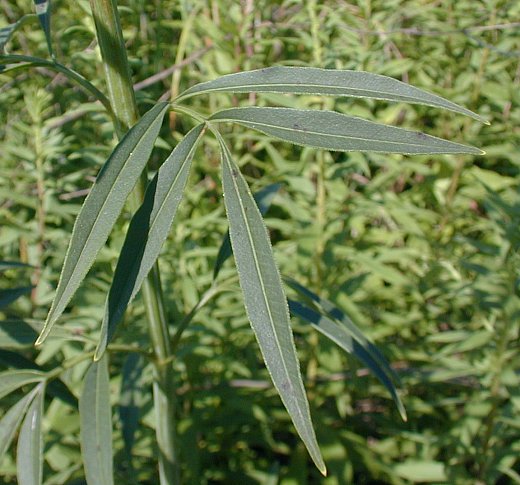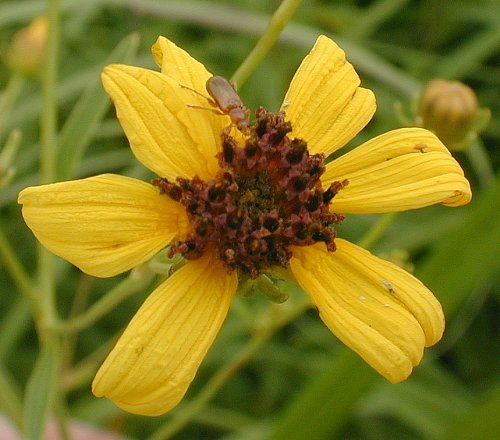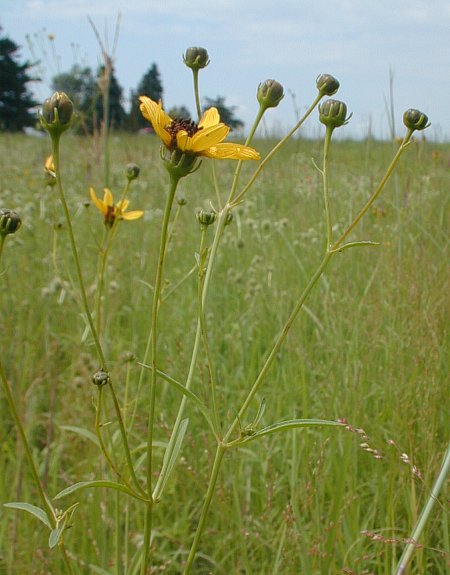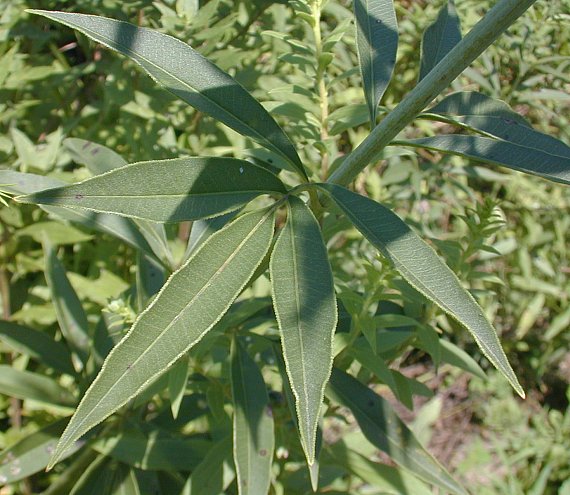Description: This perennial herbaceous plant is 3-8' tall and usually unbranched, except for flowering stems along the upper one-half of its length. The central stem and more slender upper stems are light green, terete, longitudinally veined, glabrous, and sometimes glaucous. Pairs of opposite leaves occur along the entire length of the plant, although they are more common and larger in size along the lower one-half of its length. A few solitary leaves or leafy bracts may occur alternately along the uppermost stems or flowering stalks. These leaves are ascending, widely spreading, or slightly drooping. Most leaves are odd-pinnate with 3 or 5 leaflets. Individual leaflets are up to 5" long and ¾" across; they are linear-elliptic to elliptic in shape, while their margins are entire (toothless) and often short-ciliate. The bases of leaflets are wedge-shaped, while their tips are acute. The lateral leaflets are sessile, while the terminal leaflets have petiolules (basal stalklets) less than ¼" long. The upper leaf surfaces are medium green and glabrous or nearly, while the lower leaf surfaces are light green and minutely pubescent. The petioles of leaves are up to 1½" long and light green.

The upper stems terminate in solitary to cyme-like clusters of flowerheads; flowering stalks also develop from the axils of upper leaves. Collectively, these flowerheads form a rather large and open compound inflorescence that is somewhat flat-headed. Peduncles of these flowerheads are up to 10" long, light green, terete, and glabrous. One or two leafy bracts may occur along the branches and peduncles of this inflorescence; these bracts are up to 1" long and linear-elliptic in shape. Each flowerhead spans about 1½–2" across, consisting of 8 sterile ray florets that surround a dense head of numerous fertile disk florets. The petaloid rays of the flowerheads are yellow, oblong-elliptic in shape, and widely spreading. The corollas of the disk florets are about 5 mm. long, tubular in shape, 4-5 lobed, and dark purple to maroon (reddish brown). The corolla lobes are triangular in shape and spreading to slightly recurved.

Surrounding the base of the flowerhead, there is a single series of 8 phyllaries (inner floral bracts). These phyllaries are 6-8 mm. long, ovate in shape with recurved tips, and brownish yellow during the blooming period. Below the phyllaries, there are about 8 outer floral bracts. These bracts are linear in shape and ascending; they are joined together at a shallow cup-like base. Both the bracts and cup-like base are green and glabrous (or nearly so). The blooming period occurs from mid-summer to early autumn, lasting about 1 month for a colony of plants. There is no noticeable floral scent. Afterwards, the disk florets are replaced by achenes. These achenes are 4-5 mm. long, brown, broadly oblong or oblanceolate-oblong in shape, flattened, and narrowly winged along their lateral sides. The apices of mature achenes are truncate, lacking tufts of hairs or persistent scales (immature achenes have paired scales that are early-deciduous). The root system is fibrous and long-rhizomatous, often forming loose colonies of clonal plants. Older plants may develop small woody caudices.

Cultivation:
The preference is full to partial sun and moist to mesic conditions.
This plant isn't particular about soil type, and can be found growing
in soil containing substantial amounts of loam, clay-loam, gravel, or
sand. Tall Coreopsis tolerates competition from other plants and it is
easy to grow. In moist disturbed locations, it can become aggressive.
Mature plants tolerate some drought, and foliar disease is rarely a
significant problem.
Range & Habitat:
The native Tall Coreopsis is occasional to fairly common in most
counties of Illinois, but it is uncommon or absent in the NW and SE
sections of the state (see Distribution
Map).
Habitats include black soil prairies, cemetery prairies, sand prairies,
typical savannas and sandy savannas, thickets, edges of seeps, thinly
wooded bluffs, meadows in wooded areas, limestone glades, abandoned
fields, areas along railroads, and roadsides. Tall Coreopsis occurs in
moderately disturbed to high quality habitats. It responds well to fire
in areas that have been invaded by shrubby vegetation and trees.

Faunal Associations: The nectar and pollen of the flowerheads attract a variety of insects, including bumblebees, cuckoo bees (Triepeolus spp.), digger bees (Melissodes spp.), leaf-cutting bees (Megachile spp.), Halictid bees (Halictus spp., Lasioglossum spp.), dagger bees (Calliopsis spp., Heterosarus spp.), thread-waisted wasps (Ammophila spp.) and other wasps, Syrphid flies, bee flies (Bombyliidae), Tachinid flies, butterflies, skippers, and the Goldenrod Soldier Beetle (Chauliognathus pennsylvanicus); see Robertson (1929). Other insects feed destructively on the plant juices, flowerheads, and other parts of Tall Coreopsis and other Coreopsis spp. These species include the Ragweed Leaf Beetle (Calligrapha bidenticola) and Coreopsis Leaf Beetle (Calligrapha californica coreopsivora), the Red-spotted Aster Mirid (Polymerus basalis), an aphid (Uroleucon reynoldense), and the larvae of such moths as the Dimorphic Gray (Tornos scolopacinarius, Wavy-lined Emerald (Synchlora aerata), and Common Tan Wave (Pleuroprucha insulsaria). Larvae of the latter two moths feed on the flowerheads; see Clark et al. (2004), Knight (1941), Blackman & Eastop (2013), Covell (1984/2005), and Wagner (2005) for more information. Mammalian herbivores occasionally browse on the foliage of Tall Coreopsis, especially the tender growth of young plants earlier in the year.

Photographic
Location:
The photographs were taken at the Red Bison Railroad Prairie in Savoy,
Illinois, and the Loda Cemetery Prairie in the southwest corner of
Iroquois County, Illinois.
Comments:
Tall Coreopsis (Coreopsis
tripteris) is more impressive when it occurs in loose
colonies, rather than as a stand-alone specimen. Each plant has a
tendency to sway with the passage of every breeze during a sunny
afternoon, exerting a hypnotic effect. Tall Coreopsis can be
distinguished from other
Coreopsis spp. in Illinois by its greater
height, later period of bloom, and flowerheads with dark
purple or maroon centers. In contrast, most Coreopsis spp. have
flowerheads with yellow centers. Because of its greater height, Tall
Coreopsis could be confused with one of the sunflowers (Helianthus spp.),
but it is readily distinguished from them by its odd-pinnate leaves. In
contrast, sunflowers have simple leaves.